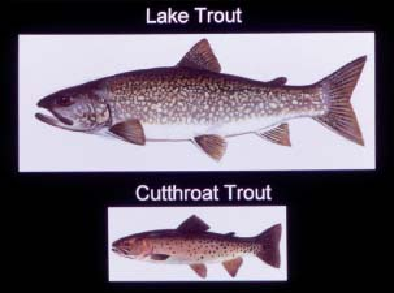Travel Reference
In-Depth Information
birds, who were beginning to be deprived of a major element of their diet, now profit by the
upsurge in the number of fish available.
There are about 20 species of fish in the Greater Yellowstone Ecosystem. The types of sport
fish most common to Yellowstone's waters are native
cutthroat trout
(Oncorhynchus clarki)
and four introduced species:
rainbow trout
(
Oncorhynchus mykiss),
brown trout
(Salmo
trutta,
brought in 1890 from Scotland and Germany),
brook trout
(Salvelinus fontinalis),
and
lake trout
(Salvelinus namaycush).
Two less common native fish are
mountain whitefish
(Prosopium williamsoni)
and
Montana grayling
(Thymallus arcticus montanus).
Fisheries in Trouble
Yellowstone's fisheries currently face four problems: predation by lake trout, tapeworms,
whirling disease, and the New Zealand mud snail invasion.
Lake Trout
Although some larger lakes of southern Yellowstone were intentionally stocked with lake
trout long ago, these large predator trout, illegally introduced into Yellowstone Lake in
1994, have caused a drastic reduction in the lake's cutthroat trout that may never be
reversed. However, the combined NPS/Yellowstone Foundation aggressive ef-
forts—gillnetting and electrofishing—had paid off by 2012: cutthroat numbers were rising,
and more lake trout than ever were being removed. In addition, it is now known where
they spawn. Meanwhile, anglers must kill all lake trout and either eat them or puncture the
air bladder and dispose of the carcass in deep water.
Diseases and an invasion

